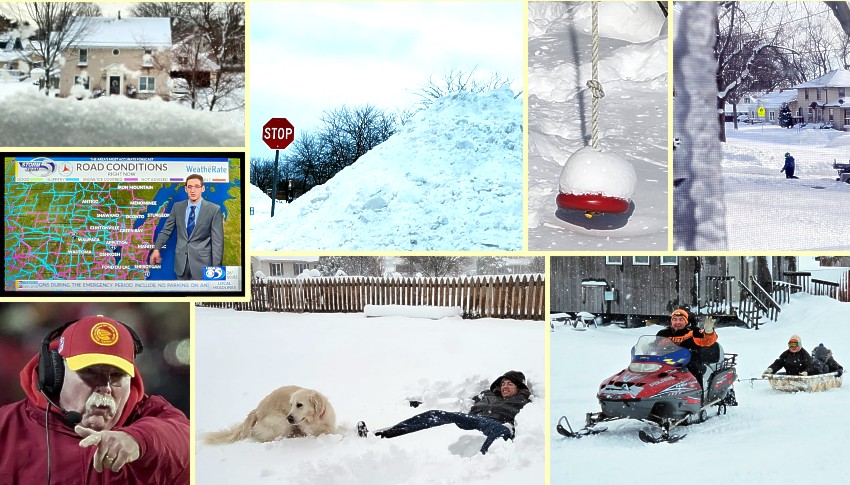Kansas Snapshots by Gloria Freeland - January 19, 2024
We and the BC
Husband Art and I arrived in his home state of Wisconsin on December 30 to visit and celebrate a late Christmas with family and
friends. Those plans went off without a hitch.
But our decision to return to Kansas on January 11 was scrubbed. A five-inch snow on January 9, and a predicted 12 inches for
January 11 made the idea of travel a non-starter and I was quite happy to stay inside while outside temperatures dropped into the
single digits and then below.
But what was this weather event they were calling a "bomb cyclone blizzard"? When I taught journalism classes, I cautioned my
students they couldn't call any old snowstorm a blizzard. According to the Associated Press Stylebook - a resource considered
the "bible" of journalists - "a blizzard has wind speeds of 35 mph or more and considerable falling and/or blowing snow with
visibility of less than one-quarter mile for three or more hours." But a bomb cyclone blizzard - what I refer to as a BC blizzard
- was a new term for me.
According to "The Weather Channel," it was first used in the 1940s. The National Oceanic and Atmospheric Administration (NOAA)
explained it's a blizzard created by a bomb cyclone. The latter term refers to a fast-developing storm - one where the atmospheric
pressure drops at least 24 millibars over a 24-hour period.
While these words are simple enough, they don't really convey much meaning for me. Part of the difficulty is because just as money
comes in different measures - dollars, euros, pesos, yen, etc. - a variety of pressure units are in use and most of us are probably
only familiar with one of them. In the United States, pounds-per-square-inch (psi) is a popular pressure unit, and I know my car's
tires are typically aired to 30 of them.
That is extremely close to two bars. A millibar is one thousandth of a bar - so that is a really small pressure difference. Yet on
weather maps, the lines are typically four millibars apart and that tiny difference in pressure is what creates the wind. The
closer together those lines, the stronger the winds.
Art likes to kid this old farm gal about how much I watch the weather forecast, but farmers live by the weather. Over the years,
I've looked at enough weather maps to know that when six of those lines - 24 millibars - move past in one day, you'd better have
fastened the barn door securely because the winds will be impressive!
Meteorologists warned people that this BC could include heavy winds, blizzard conditions, heavy snow with reduced visibility, and
even rainfall causing coastal flooding.
Check, check, check and check.
Since temperature disparities are the principal driver of pressure differences, BCs are accompanied by dramatic temperature shifts.
Check again.
These sorts of changes are old hat to friend Bryce, who spends his odd-numbered months as a medical doctor in Alaska. While based
in Nome, he also travels to Savoonga, population 835, one of the Alaskan villages on the St. Lawrence Islands in the Bering Sea,
to treat the residents. Bryce was scheduled to return to Nome last Thursday, but heavy snow and wind postponed his flight. He said
the snow and winds made it hard to walk to the store to get groceries. And with Savoonga being so far north, there are few daylight
hours to shop. Recent sightings of polar bears in the area add an additional layer of anxiety.
But he has a healthy attitude about it.
... If I look at it from the perspective of "an old man gets to have an adventure," it's pretty interesting. One has to adapt and
improvise, just like a camper or hiker does on multi-day trips....
The January 14 Kansas City Chiefs-Miami Dolphins football game was played in weather created by the BC and, seeing Chiefs' coach
Andy Reid with icicles hanging from his mustache drove home the on-field conditions. The -4F temperature made it one of the coldest
ever played by National Football League teams.
Art was in the stands with six of his family when the NFL's coldest - the Ice Bowl - game was played just 30 miles northeast of
here on December 31, 1967. The game-time temperature hovered at -13F and the Packers' opponent that day was the Dallas Cowboys,
coincidentally the same team they played this past weekend. Art said that while it was cold, the stands were full because people
had on their winter gear. Since seat spacing was designed for the balmier days of fall, everyone was packed so tightly that going
to the bathroom was a trip most people deferred as long as they could.
On the day the BC blizzard struck us, we woke up to the ground covered in the white stuff, with big flakes coming down throughout
the day. The winds threw the snow onto the windows - even the second-story ones - which eventually iced over.
But we had plenty of food and a warm home, and enjoyed watching as snow plows cleared the street and neighbors ventured out to
shovel snow from driveways and sidewalks.
As I write this, I'm sitting in a comfortable chair with a blanket over my lap. Our cat Minnie is sprawled on my legs. The ice on
the windows is starting to leave. Art pointed out that it departs not by melting, but by a process called "sublimation."
I didnít ask. My science apetite had been temporarily satisfied!
